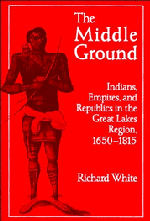Book contents
- Frontmatter
- Contents
- List of abbreviations
- Introduction
- 1 Refugees: a world made of fragments
- 2 The middle ground
- 3 The fur trade
- 4 The alliance
- 5 Republicans and rebels
- 6 The clash of empires
- 7 Pontiac and the restoration of the middle ground
- 8 The British alliance
- 9 The contest of villagers
- 10 Confederacies
- 11 The politics of benevolence
- Epilogue: Assimilation and otherness
- Index
6 - The clash of empires
Published online by Cambridge University Press: 05 August 2012
- Frontmatter
- Contents
- List of abbreviations
- Introduction
- 1 Refugees: a world made of fragments
- 2 The middle ground
- 3 The fur trade
- 4 The alliance
- 5 Republicans and rebels
- 6 The clash of empires
- 7 Pontiac and the restoration of the middle ground
- 8 The British alliance
- 9 The contest of villagers
- 10 Confederacies
- 11 The politics of benevolence
- Epilogue: Assimilation and otherness
- Index
Summary
Informed by Thomas Kinton that before ye Indn War, he being out here at a Town a little way up ye Alegheny, where the Indians found a Rat & Kill'd it which yet antiants of them seem'd Concearned & told him that ye French or British should get that Land from them, ye same prediction being made by their Grandfathers on finding a Rat on Delaware before ye White People Came there.
“Journal of James Kenny,” March 19, 1762As long as Pickawillany and the Ohio republics survived, Onontio regarded them as a knife poised to sever Canada from Louisiana. The British, or so the French believed, wielded the knife. By the early 1750s, both the British and the French had convinced themselves that the outcome of the political struggle in the villages along the Ohio and the Wabash would decide the imperial struggle on the American continent. To William Johnson, soon to emerge as the most critical figure in formulating British Indian policy, the Indians of the Ohio seemed
the only Body of Indians now upon the Continent whose Friendship or alliance is most worthy of courting or continuing wherefore if we lose them (who have been for these three years past so firmly attached to the British Interests as by sundry instances can be made appear) it must be our own faults & the consequences may be very bad.
On the French side, Governor de La Galissonière made the Ohio Valley the key to the continent.
- Type
- Chapter
- Information
- The Middle GroundIndians, Empires, and Republics in the Great Lakes Region, 1650–1815, pp. 223 - 268Publisher: Cambridge University PressPrint publication year: 1991

